The Racial State, Body Language, Gender, Sexuality, and Race Analysis
VerifiedAdded on 2021/02/21
|8
|2525
|134
Homework Assignment
AI Summary
This assignment delves into the multifaceted nature of racism, body language, and their intersection with gender and sexuality. It begins by defining everyday racism as a social construct, exploring its historical context and impact on individuals through personal experiences and real-world examples like the New Zealand massacre. The assignment then analyzes body language as a form of non-verbal communication, discussing how facial expressions, gestures, and posture convey emotions and influence perceptions. Finally, it examines how gender and sexuality intersect with race, considering the impact of social classifications and inequalities on individuals' experiences and well-being. The assignment underscores the importance of understanding these complex social dynamics to promote equality and justice.
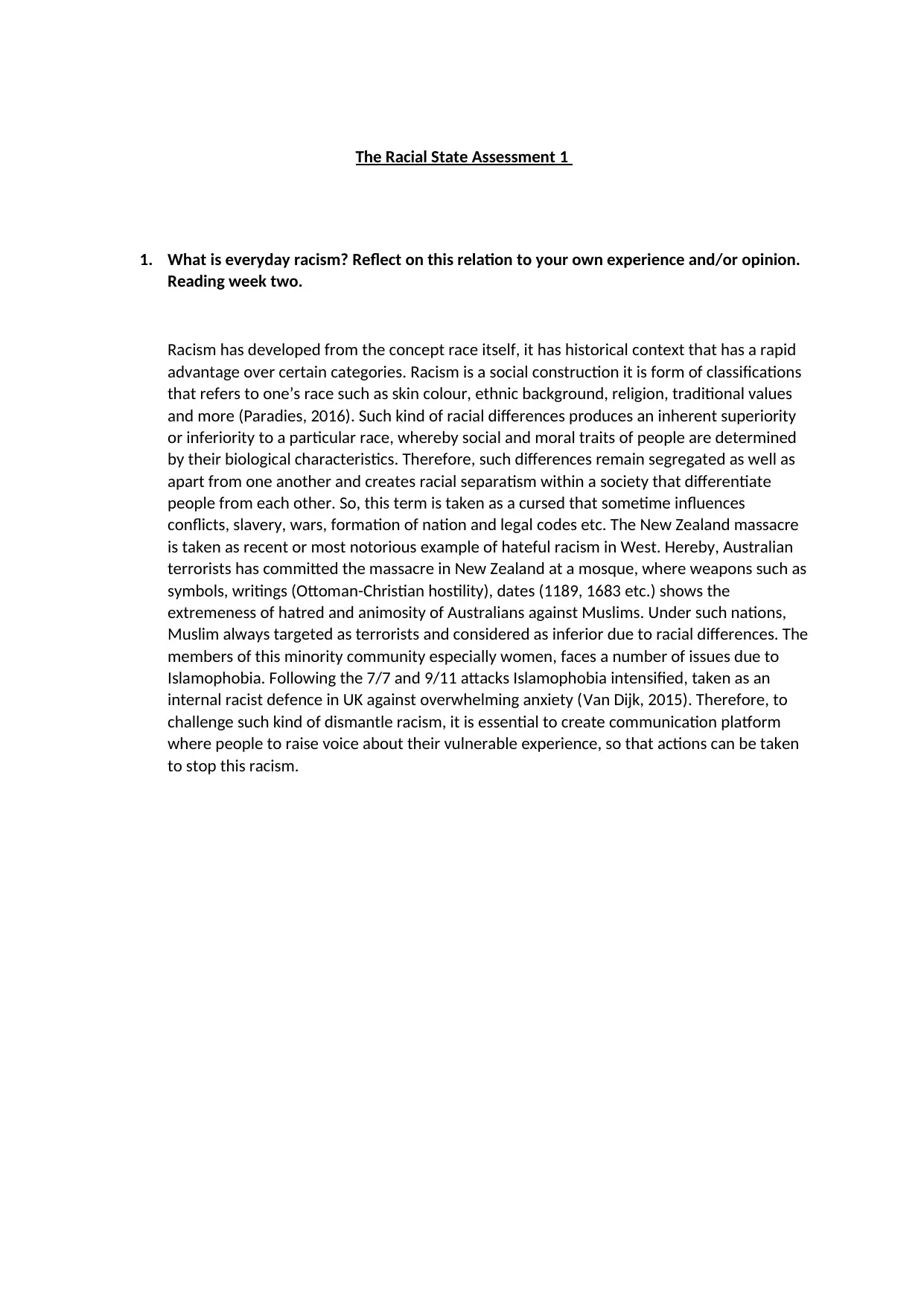
The Racial State Assessment 1
1. What is everyday racism? Reflect on this relation to your own experience and/or opinion.
Reading week two.
Racism has developed from the concept race itself, it has historical context that has a rapid
advantage over certain categories. Racism is a social construction it is form of classifications
that refers to one’s race such as skin colour, ethnic background, religion, traditional values
and more (Paradies, 2016). Such kind of racial differences produces an inherent superiority
or inferiority to a particular race, whereby social and moral traits of people are determined
by their biological characteristics. Therefore, such differences remain segregated as well as
apart from one another and creates racial separatism within a society that differentiate
people from each other. So, this term is taken as a cursed that sometime influences
conflicts, slavery, wars, formation of nation and legal codes etc. The New Zealand massacre
is taken as recent or most notorious example of hateful racism in West. Hereby, Australian
terrorists has committed the massacre in New Zealand at a mosque, where weapons such as
symbols, writings (Ottoman-Christian hostility), dates (1189, 1683 etc.) shows the
extremeness of hatred and animosity of Australians against Muslims. Under such nations,
Muslim always targeted as terrorists and considered as inferior due to racial differences. The
members of this minority community especially women, faces a number of issues due to
Islamophobia. Following the 7/7 and 9/11 attacks Islamophobia intensified, taken as an
internal racist defence in UK against overwhelming anxiety (Van Dijk, 2015). Therefore, to
challenge such kind of dismantle racism, it is essential to create communication platform
where people to raise voice about their vulnerable experience, so that actions can be taken
to stop this racism.
1. What is everyday racism? Reflect on this relation to your own experience and/or opinion.
Reading week two.
Racism has developed from the concept race itself, it has historical context that has a rapid
advantage over certain categories. Racism is a social construction it is form of classifications
that refers to one’s race such as skin colour, ethnic background, religion, traditional values
and more (Paradies, 2016). Such kind of racial differences produces an inherent superiority
or inferiority to a particular race, whereby social and moral traits of people are determined
by their biological characteristics. Therefore, such differences remain segregated as well as
apart from one another and creates racial separatism within a society that differentiate
people from each other. So, this term is taken as a cursed that sometime influences
conflicts, slavery, wars, formation of nation and legal codes etc. The New Zealand massacre
is taken as recent or most notorious example of hateful racism in West. Hereby, Australian
terrorists has committed the massacre in New Zealand at a mosque, where weapons such as
symbols, writings (Ottoman-Christian hostility), dates (1189, 1683 etc.) shows the
extremeness of hatred and animosity of Australians against Muslims. Under such nations,
Muslim always targeted as terrorists and considered as inferior due to racial differences. The
members of this minority community especially women, faces a number of issues due to
Islamophobia. Following the 7/7 and 9/11 attacks Islamophobia intensified, taken as an
internal racist defence in UK against overwhelming anxiety (Van Dijk, 2015). Therefore, to
challenge such kind of dismantle racism, it is essential to create communication platform
where people to raise voice about their vulnerable experience, so that actions can be taken
to stop this racism.
Paraphrase This Document
Need a fresh take? Get an instant paraphrase of this document with our AI Paraphraser

My experience in relation to encountering racism is based on physical appearance. Although
I am a Muslim non scarfed I was with a Muslim friend who was scarfed, we were on the way
to mosque during Ramadan at night. As we stopped by a petrol station to fill up petrol we
encountered a stranger who was identify to be a white male in his late 40’s he looked at my
friend who had the scarf on and said take that “rag off your head”. I looked over to him with
confusion and shock he just smiled to me not knowing I was Muslim as well just without the
head scarf on. This experience has made me feel very uncomfortable knowing that racism is
not from a historical context because yet till this day we encounter all different types of
racism everyday especially Muslim women who are scarfed. In saying this, Neil Macmaster
(2001) mentions “Racism is always a dynamic process, a set of beliefs and practices that is
embedded in a particular historical context, a particular social formation, and is thus
continuously undergoing change, a plastic or chameleon-like phenomenon which constantly
finds new forms of political, social cultural or linguistic expression. (Macmaster, 2001, p.14).
This racialized control was clearly articulated over the years throughout many countries not
just Australia that ‘Islamophobia’ is real, it is an aggressive behaviour that follows Muslims
around the world judged and being accused of being terrorists. Ideally, such discourse brings
the ethnic or religious kind of discrimination not only in society but at extreme level where
countries are at stage of war, just because of racism. Along with this, such type of close-
minded inhumane rhetoric where people are judged by their physical appearance, clothes
and biological characteristics. It is also being revived under political environment, restoring
the value of freedom and human rights, cradles of modernity and so on. Thus, from all over
discussion, it has been analysed that today, stigma, injustice in civil rights, inequalities in
human beings due to certain characteristics, remain remarkable in society. Hereby, skin
colour considered as the main characteristic through which people are valued, viewed and
treated in society (Van Dijk, 2015) (Paradies, 2016). Thus, this kind on intentionally or
unintentionally behaviour create a large impact on well-being and health of society,
surrounded people as well as stifles the opportunities also, that contributes to growth and
development of nation. Therefore, government of all over nations, needs to take actions
I am a Muslim non scarfed I was with a Muslim friend who was scarfed, we were on the way
to mosque during Ramadan at night. As we stopped by a petrol station to fill up petrol we
encountered a stranger who was identify to be a white male in his late 40’s he looked at my
friend who had the scarf on and said take that “rag off your head”. I looked over to him with
confusion and shock he just smiled to me not knowing I was Muslim as well just without the
head scarf on. This experience has made me feel very uncomfortable knowing that racism is
not from a historical context because yet till this day we encounter all different types of
racism everyday especially Muslim women who are scarfed. In saying this, Neil Macmaster
(2001) mentions “Racism is always a dynamic process, a set of beliefs and practices that is
embedded in a particular historical context, a particular social formation, and is thus
continuously undergoing change, a plastic or chameleon-like phenomenon which constantly
finds new forms of political, social cultural or linguistic expression. (Macmaster, 2001, p.14).
This racialized control was clearly articulated over the years throughout many countries not
just Australia that ‘Islamophobia’ is real, it is an aggressive behaviour that follows Muslims
around the world judged and being accused of being terrorists. Ideally, such discourse brings
the ethnic or religious kind of discrimination not only in society but at extreme level where
countries are at stage of war, just because of racism. Along with this, such type of close-
minded inhumane rhetoric where people are judged by their physical appearance, clothes
and biological characteristics. It is also being revived under political environment, restoring
the value of freedom and human rights, cradles of modernity and so on. Thus, from all over
discussion, it has been analysed that today, stigma, injustice in civil rights, inequalities in
human beings due to certain characteristics, remain remarkable in society. Hereby, skin
colour considered as the main characteristic through which people are valued, viewed and
treated in society (Van Dijk, 2015) (Paradies, 2016). Thus, this kind on intentionally or
unintentionally behaviour create a large impact on well-being and health of society,
surrounded people as well as stifles the opportunities also, that contributes to growth and
development of nation. Therefore, government of all over nations, needs to take actions
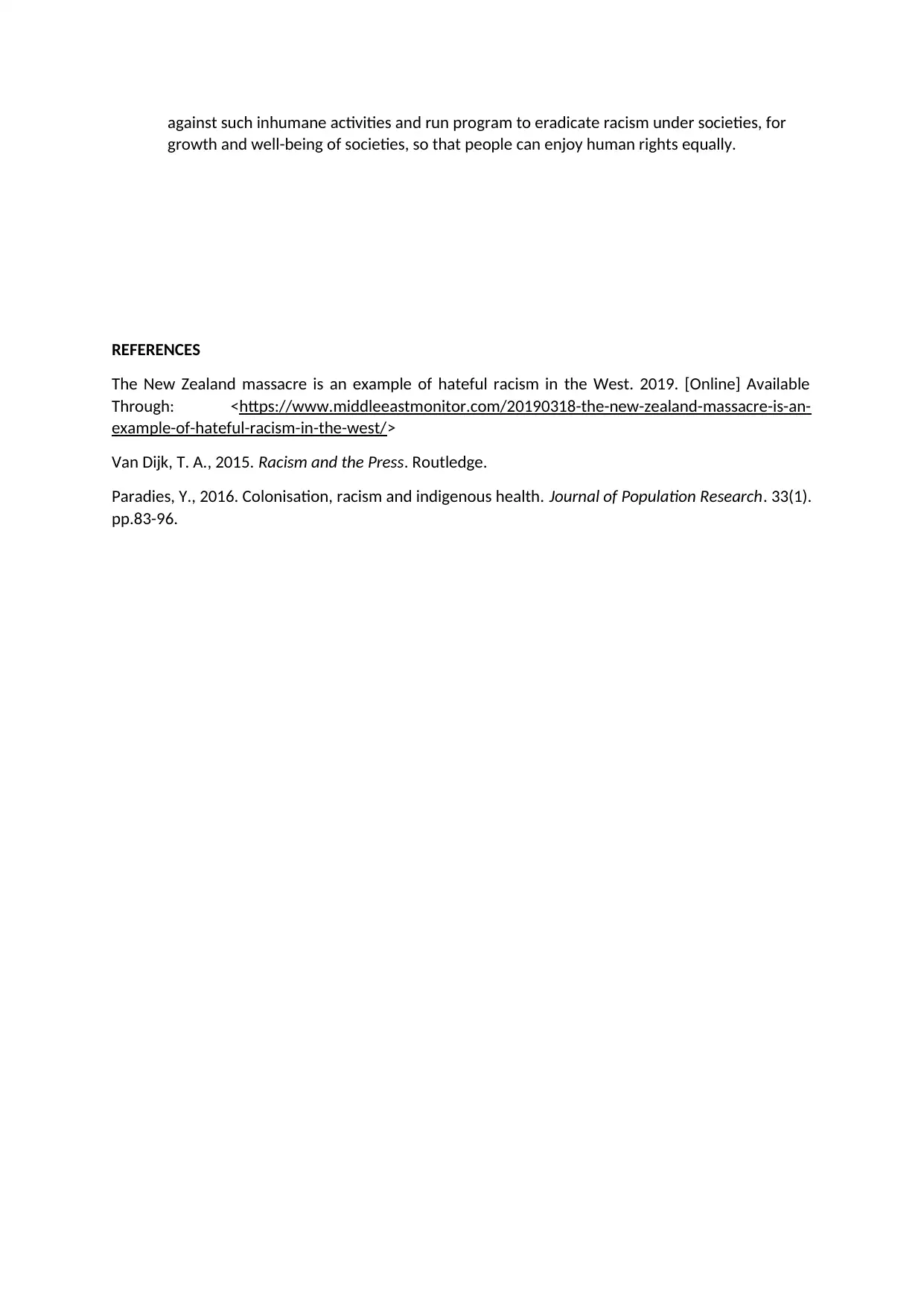
against such inhumane activities and run program to eradicate racism under societies, for
growth and well-being of societies, so that people can enjoy human rights equally.
REFERENCES
The New Zealand massacre is an example of hateful racism in the West. 2019. [Online] Available
Through: <https://www.middleeastmonitor.com/20190318-the-new-zealand-massacre-is-an-
example-of-hateful-racism-in-the-west/>
Van Dijk, T. A., 2015. Racism and the Press. Routledge.
Paradies, Y., 2016. Colonisation, racism and indigenous health. Journal of Population Research. 33(1).
pp.83-96.
growth and well-being of societies, so that people can enjoy human rights equally.
REFERENCES
The New Zealand massacre is an example of hateful racism in the West. 2019. [Online] Available
Through: <https://www.middleeastmonitor.com/20190318-the-new-zealand-massacre-is-an-
example-of-hateful-racism-in-the-west/>
Van Dijk, T. A., 2015. Racism and the Press. Routledge.
Paradies, Y., 2016. Colonisation, racism and indigenous health. Journal of Population Research. 33(1).
pp.83-96.
⊘ This is a preview!⊘
Do you want full access?
Subscribe today to unlock all pages.

Trusted by 1+ million students worldwide
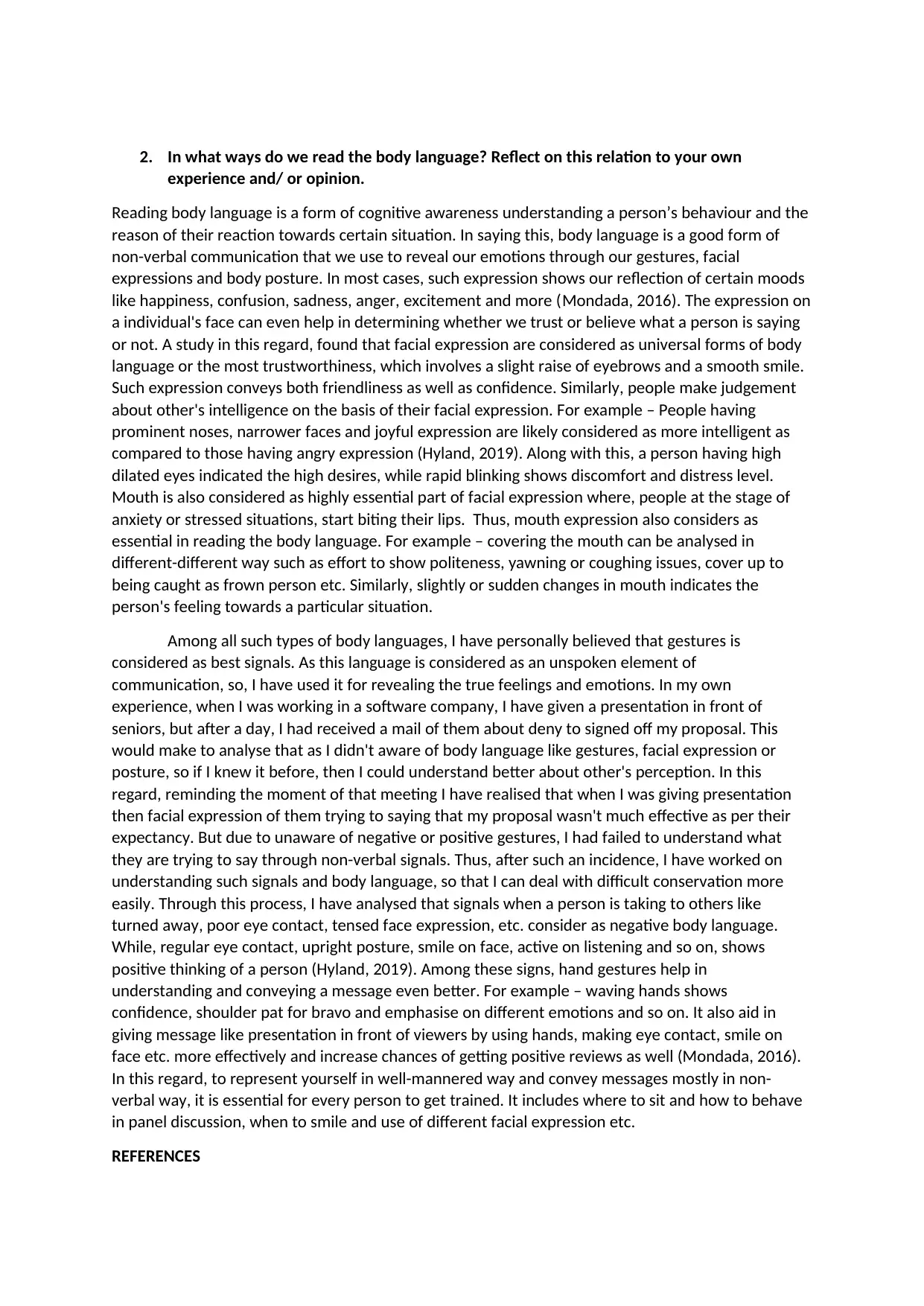
2. In what ways do we read the body language? Reflect on this relation to your own
experience and/ or opinion.
Reading body language is a form of cognitive awareness understanding a person’s behaviour and the
reason of their reaction towards certain situation. In saying this, body language is a good form of
non-verbal communication that we use to reveal our emotions through our gestures, facial
expressions and body posture. In most cases, such expression shows our reflection of certain moods
like happiness, confusion, sadness, anger, excitement and more (Mondada, 2016). The expression on
a individual's face can even help in determining whether we trust or believe what a person is saying
or not. A study in this regard, found that facial expression are considered as universal forms of body
language or the most trustworthiness, which involves a slight raise of eyebrows and a smooth smile.
Such expression conveys both friendliness as well as confidence. Similarly, people make judgement
about other's intelligence on the basis of their facial expression. For example – People having
prominent noses, narrower faces and joyful expression are likely considered as more intelligent as
compared to those having angry expression (Hyland, 2019). Along with this, a person having high
dilated eyes indicated the high desires, while rapid blinking shows discomfort and distress level.
Mouth is also considered as highly essential part of facial expression where, people at the stage of
anxiety or stressed situations, start biting their lips. Thus, mouth expression also considers as
essential in reading the body language. For example – covering the mouth can be analysed in
different-different way such as effort to show politeness, yawning or coughing issues, cover up to
being caught as frown person etc. Similarly, slightly or sudden changes in mouth indicates the
person's feeling towards a particular situation.
Among all such types of body languages, I have personally believed that gestures is
considered as best signals. As this language is considered as an unspoken element of
communication, so, I have used it for revealing the true feelings and emotions. In my own
experience, when I was working in a software company, I have given a presentation in front of
seniors, but after a day, I had received a mail of them about deny to signed off my proposal. This
would make to analyse that as I didn't aware of body language like gestures, facial expression or
posture, so if I knew it before, then I could understand better about other's perception. In this
regard, reminding the moment of that meeting I have realised that when I was giving presentation
then facial expression of them trying to saying that my proposal wasn't much effective as per their
expectancy. But due to unaware of negative or positive gestures, I had failed to understand what
they are trying to say through non-verbal signals. Thus, after such an incidence, I have worked on
understanding such signals and body language, so that I can deal with difficult conservation more
easily. Through this process, I have analysed that signals when a person is taking to others like
turned away, poor eye contact, tensed face expression, etc. consider as negative body language.
While, regular eye contact, upright posture, smile on face, active on listening and so on, shows
positive thinking of a person (Hyland, 2019). Among these signs, hand gestures help in
understanding and conveying a message even better. For example – waving hands shows
confidence, shoulder pat for bravo and emphasise on different emotions and so on. It also aid in
giving message like presentation in front of viewers by using hands, making eye contact, smile on
face etc. more effectively and increase chances of getting positive reviews as well (Mondada, 2016).
In this regard, to represent yourself in well-mannered way and convey messages mostly in non-
verbal way, it is essential for every person to get trained. It includes where to sit and how to behave
in panel discussion, when to smile and use of different facial expression etc.
REFERENCES
experience and/ or opinion.
Reading body language is a form of cognitive awareness understanding a person’s behaviour and the
reason of their reaction towards certain situation. In saying this, body language is a good form of
non-verbal communication that we use to reveal our emotions through our gestures, facial
expressions and body posture. In most cases, such expression shows our reflection of certain moods
like happiness, confusion, sadness, anger, excitement and more (Mondada, 2016). The expression on
a individual's face can even help in determining whether we trust or believe what a person is saying
or not. A study in this regard, found that facial expression are considered as universal forms of body
language or the most trustworthiness, which involves a slight raise of eyebrows and a smooth smile.
Such expression conveys both friendliness as well as confidence. Similarly, people make judgement
about other's intelligence on the basis of their facial expression. For example – People having
prominent noses, narrower faces and joyful expression are likely considered as more intelligent as
compared to those having angry expression (Hyland, 2019). Along with this, a person having high
dilated eyes indicated the high desires, while rapid blinking shows discomfort and distress level.
Mouth is also considered as highly essential part of facial expression where, people at the stage of
anxiety or stressed situations, start biting their lips. Thus, mouth expression also considers as
essential in reading the body language. For example – covering the mouth can be analysed in
different-different way such as effort to show politeness, yawning or coughing issues, cover up to
being caught as frown person etc. Similarly, slightly or sudden changes in mouth indicates the
person's feeling towards a particular situation.
Among all such types of body languages, I have personally believed that gestures is
considered as best signals. As this language is considered as an unspoken element of
communication, so, I have used it for revealing the true feelings and emotions. In my own
experience, when I was working in a software company, I have given a presentation in front of
seniors, but after a day, I had received a mail of them about deny to signed off my proposal. This
would make to analyse that as I didn't aware of body language like gestures, facial expression or
posture, so if I knew it before, then I could understand better about other's perception. In this
regard, reminding the moment of that meeting I have realised that when I was giving presentation
then facial expression of them trying to saying that my proposal wasn't much effective as per their
expectancy. But due to unaware of negative or positive gestures, I had failed to understand what
they are trying to say through non-verbal signals. Thus, after such an incidence, I have worked on
understanding such signals and body language, so that I can deal with difficult conservation more
easily. Through this process, I have analysed that signals when a person is taking to others like
turned away, poor eye contact, tensed face expression, etc. consider as negative body language.
While, regular eye contact, upright posture, smile on face, active on listening and so on, shows
positive thinking of a person (Hyland, 2019). Among these signs, hand gestures help in
understanding and conveying a message even better. For example – waving hands shows
confidence, shoulder pat for bravo and emphasise on different emotions and so on. It also aid in
giving message like presentation in front of viewers by using hands, making eye contact, smile on
face etc. more effectively and increase chances of getting positive reviews as well (Mondada, 2016).
In this regard, to represent yourself in well-mannered way and convey messages mostly in non-
verbal way, it is essential for every person to get trained. It includes where to sit and how to behave
in panel discussion, when to smile and use of different facial expression etc.
REFERENCES
Paraphrase This Document
Need a fresh take? Get an instant paraphrase of this document with our AI Paraphraser
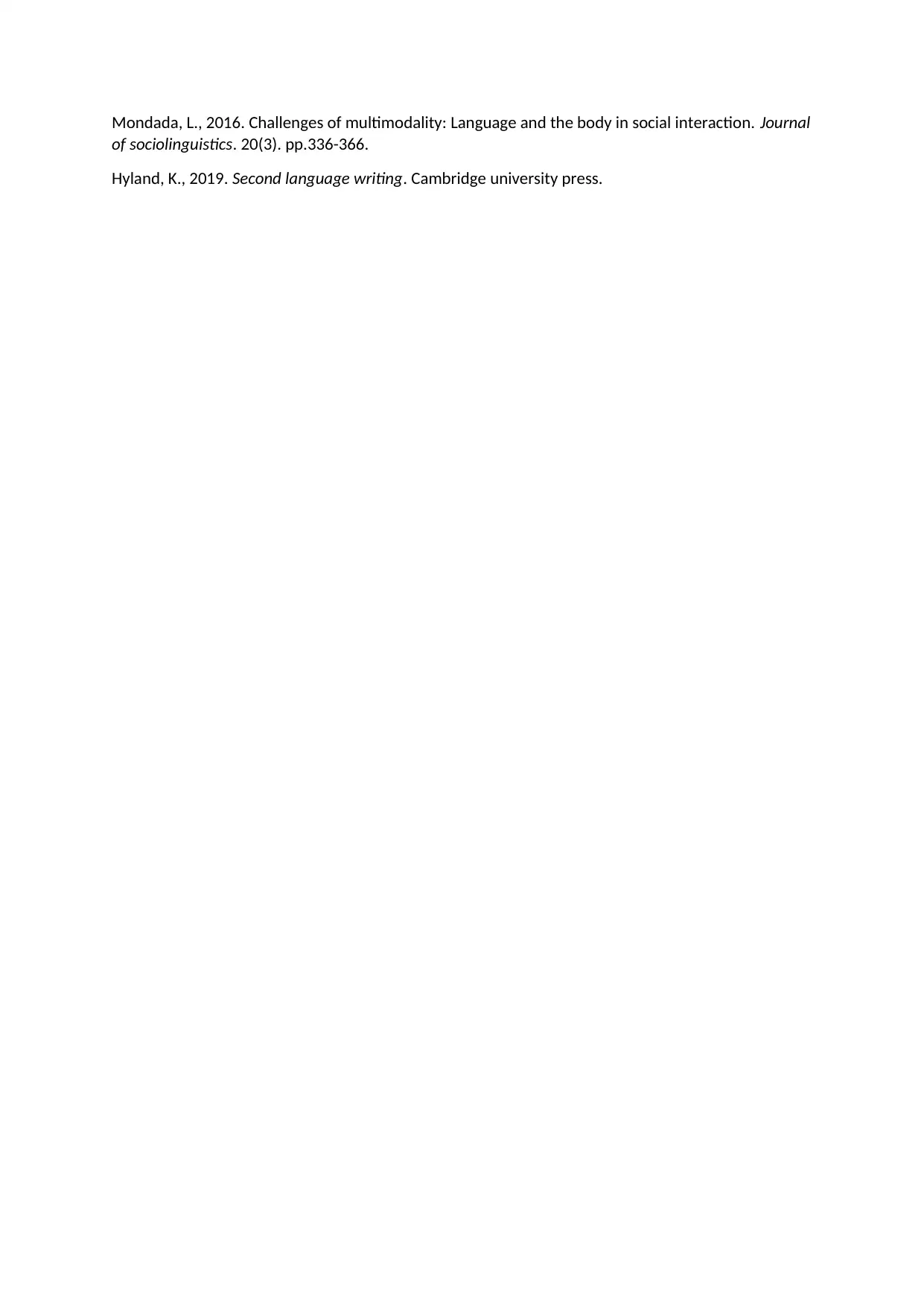
Mondada, L., 2016. Challenges of multimodality: Language and the body in social interaction. Journal
of sociolinguistics. 20(3). pp.336-366.
Hyland, K., 2019. Second language writing. Cambridge university press.
of sociolinguistics. 20(3). pp.336-366.
Hyland, K., 2019. Second language writing. Cambridge university press.
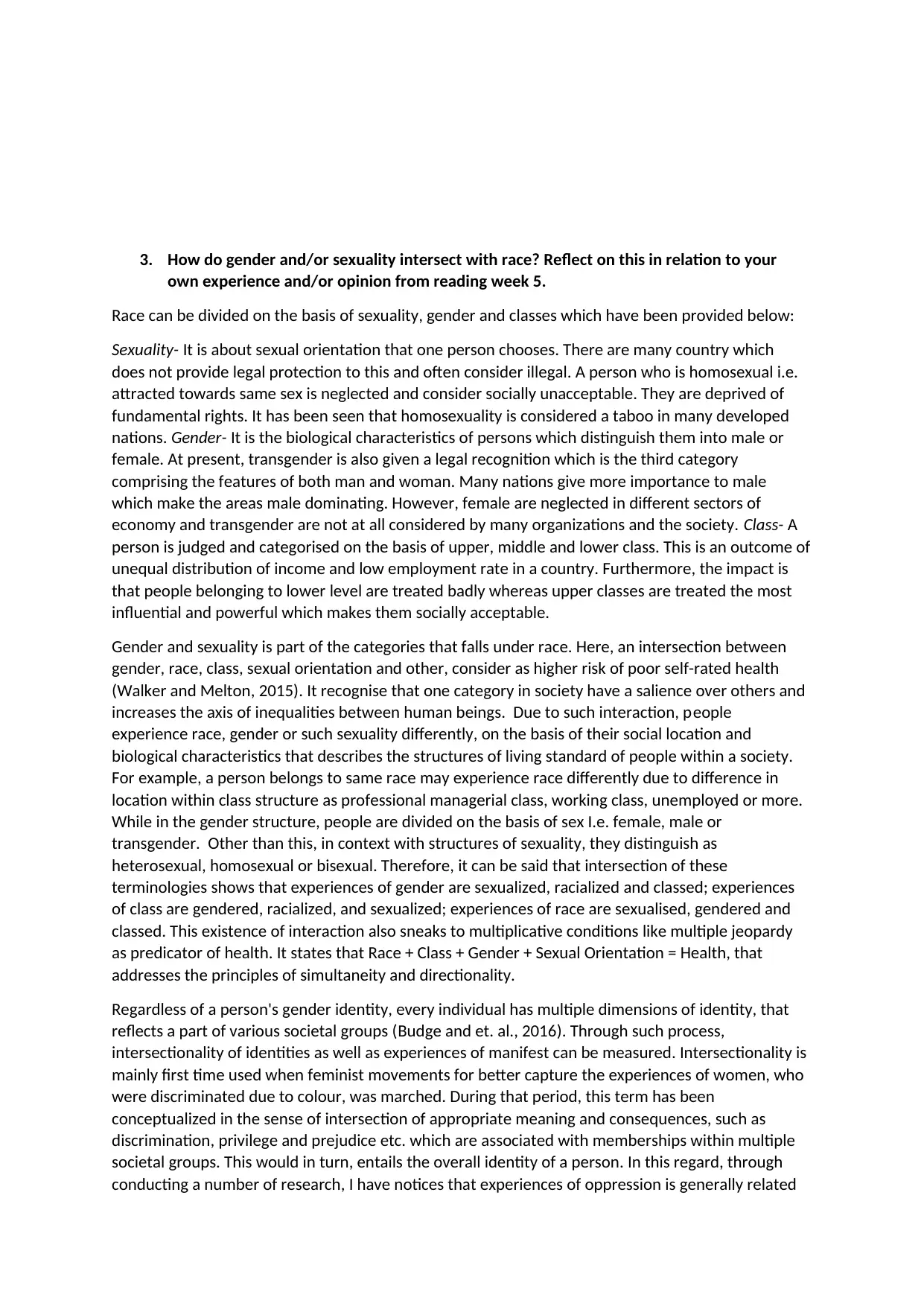
3. How do gender and/or sexuality intersect with race? Reflect on this in relation to your
own experience and/or opinion from reading week 5.
Race can be divided on the basis of sexuality, gender and classes which have been provided below:
Sexuality- It is about sexual orientation that one person chooses. There are many country which
does not provide legal protection to this and often consider illegal. A person who is homosexual i.e.
attracted towards same sex is neglected and consider socially unacceptable. They are deprived of
fundamental rights. It has been seen that homosexuality is considered a taboo in many developed
nations. Gender- It is the biological characteristics of persons which distinguish them into male or
female. At present, transgender is also given a legal recognition which is the third category
comprising the features of both man and woman. Many nations give more importance to male
which make the areas male dominating. However, female are neglected in different sectors of
economy and transgender are not at all considered by many organizations and the society. Class- A
person is judged and categorised on the basis of upper, middle and lower class. This is an outcome of
unequal distribution of income and low employment rate in a country. Furthermore, the impact is
that people belonging to lower level are treated badly whereas upper classes are treated the most
influential and powerful which makes them socially acceptable.
Gender and sexuality is part of the categories that falls under race. Here, an intersection between
gender, race, class, sexual orientation and other, consider as higher risk of poor self-rated health
(Walker and Melton, 2015). It recognise that one category in society have a salience over others and
increases the axis of inequalities between human beings. Due to such interaction, people
experience race, gender or such sexuality differently, on the basis of their social location and
biological characteristics that describes the structures of living standard of people within a society.
For example, a person belongs to same race may experience race differently due to difference in
location within class structure as professional managerial class, working class, unemployed or more.
While in the gender structure, people are divided on the basis of sex I.e. female, male or
transgender. Other than this, in context with structures of sexuality, they distinguish as
heterosexual, homosexual or bisexual. Therefore, it can be said that intersection of these
terminologies shows that experiences of gender are sexualized, racialized and classed; experiences
of class are gendered, racialized, and sexualized; experiences of race are sexualised, gendered and
classed. This existence of interaction also sneaks to multiplicative conditions like multiple jeopardy
as predicator of health. It states that Race + Class + Gender + Sexual Orientation = Health, that
addresses the principles of simultaneity and directionality.
Regardless of a person's gender identity, every individual has multiple dimensions of identity, that
reflects a part of various societal groups (Budge and et. al., 2016). Through such process,
intersectionality of identities as well as experiences of manifest can be measured. Intersectionality is
mainly first time used when feminist movements for better capture the experiences of women, who
were discriminated due to colour, was marched. During that period, this term has been
conceptualized in the sense of intersection of appropriate meaning and consequences, such as
discrimination, privilege and prejudice etc. which are associated with memberships within multiple
societal groups. This would in turn, entails the overall identity of a person. In this regard, through
conducting a number of research, I have notices that experiences of oppression is generally related
own experience and/or opinion from reading week 5.
Race can be divided on the basis of sexuality, gender and classes which have been provided below:
Sexuality- It is about sexual orientation that one person chooses. There are many country which
does not provide legal protection to this and often consider illegal. A person who is homosexual i.e.
attracted towards same sex is neglected and consider socially unacceptable. They are deprived of
fundamental rights. It has been seen that homosexuality is considered a taboo in many developed
nations. Gender- It is the biological characteristics of persons which distinguish them into male or
female. At present, transgender is also given a legal recognition which is the third category
comprising the features of both man and woman. Many nations give more importance to male
which make the areas male dominating. However, female are neglected in different sectors of
economy and transgender are not at all considered by many organizations and the society. Class- A
person is judged and categorised on the basis of upper, middle and lower class. This is an outcome of
unequal distribution of income and low employment rate in a country. Furthermore, the impact is
that people belonging to lower level are treated badly whereas upper classes are treated the most
influential and powerful which makes them socially acceptable.
Gender and sexuality is part of the categories that falls under race. Here, an intersection between
gender, race, class, sexual orientation and other, consider as higher risk of poor self-rated health
(Walker and Melton, 2015). It recognise that one category in society have a salience over others and
increases the axis of inequalities between human beings. Due to such interaction, people
experience race, gender or such sexuality differently, on the basis of their social location and
biological characteristics that describes the structures of living standard of people within a society.
For example, a person belongs to same race may experience race differently due to difference in
location within class structure as professional managerial class, working class, unemployed or more.
While in the gender structure, people are divided on the basis of sex I.e. female, male or
transgender. Other than this, in context with structures of sexuality, they distinguish as
heterosexual, homosexual or bisexual. Therefore, it can be said that intersection of these
terminologies shows that experiences of gender are sexualized, racialized and classed; experiences
of class are gendered, racialized, and sexualized; experiences of race are sexualised, gendered and
classed. This existence of interaction also sneaks to multiplicative conditions like multiple jeopardy
as predicator of health. It states that Race + Class + Gender + Sexual Orientation = Health, that
addresses the principles of simultaneity and directionality.
Regardless of a person's gender identity, every individual has multiple dimensions of identity, that
reflects a part of various societal groups (Budge and et. al., 2016). Through such process,
intersectionality of identities as well as experiences of manifest can be measured. Intersectionality is
mainly first time used when feminist movements for better capture the experiences of women, who
were discriminated due to colour, was marched. During that period, this term has been
conceptualized in the sense of intersection of appropriate meaning and consequences, such as
discrimination, privilege and prejudice etc. which are associated with memberships within multiple
societal groups. This would in turn, entails the overall identity of a person. In this regard, through
conducting a number of research, I have notices that experiences of oppression is generally related
⊘ This is a preview!⊘
Do you want full access?
Subscribe today to unlock all pages.

Trusted by 1+ million students worldwide
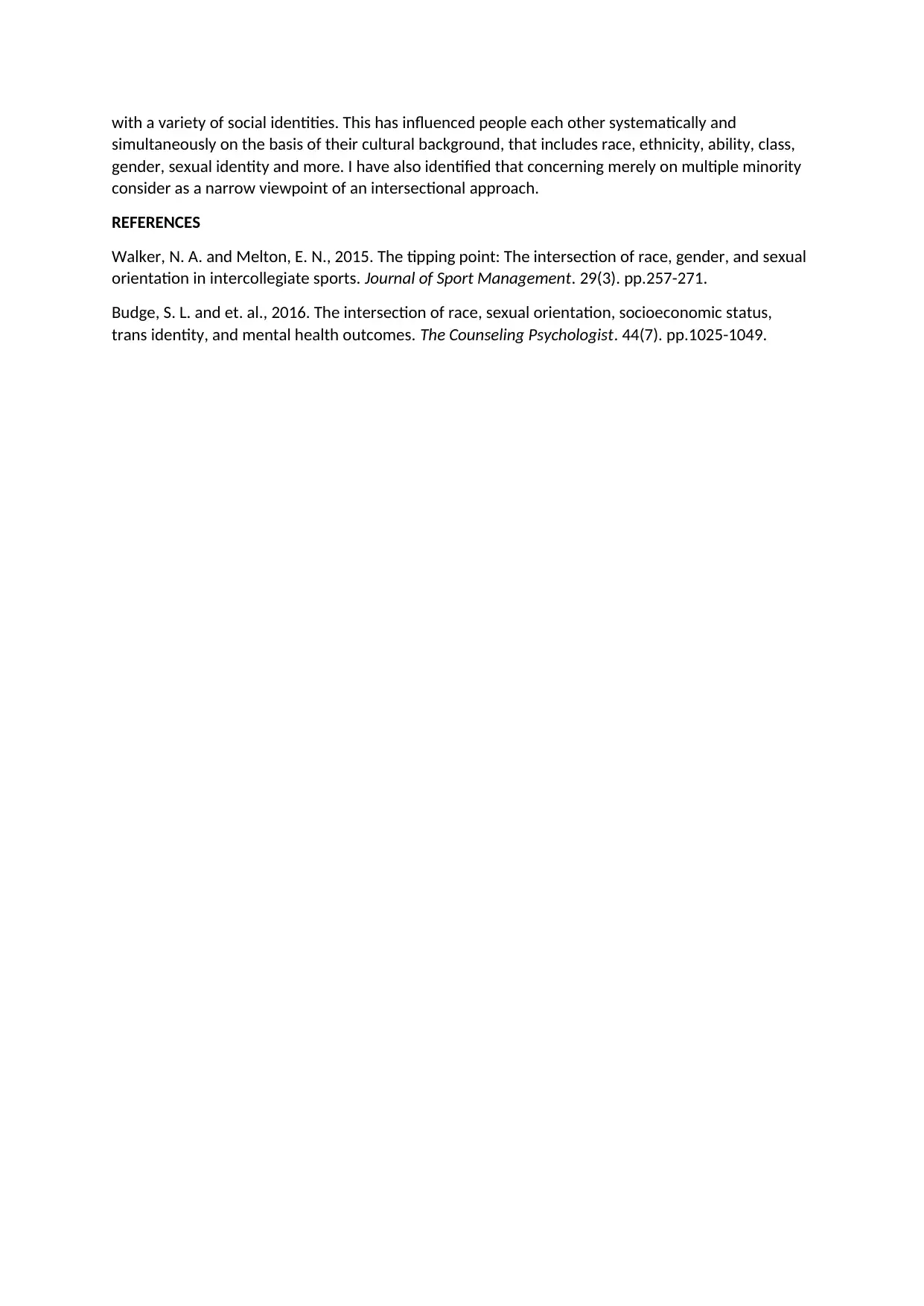
with a variety of social identities. This has influenced people each other systematically and
simultaneously on the basis of their cultural background, that includes race, ethnicity, ability, class,
gender, sexual identity and more. I have also identified that concerning merely on multiple minority
consider as a narrow viewpoint of an intersectional approach.
REFERENCES
Walker, N. A. and Melton, E. N., 2015. The tipping point: The intersection of race, gender, and sexual
orientation in intercollegiate sports. Journal of Sport Management. 29(3). pp.257-271.
Budge, S. L. and et. al., 2016. The intersection of race, sexual orientation, socioeconomic status,
trans identity, and mental health outcomes. The Counseling Psychologist. 44(7). pp.1025-1049.
simultaneously on the basis of their cultural background, that includes race, ethnicity, ability, class,
gender, sexual identity and more. I have also identified that concerning merely on multiple minority
consider as a narrow viewpoint of an intersectional approach.
REFERENCES
Walker, N. A. and Melton, E. N., 2015. The tipping point: The intersection of race, gender, and sexual
orientation in intercollegiate sports. Journal of Sport Management. 29(3). pp.257-271.
Budge, S. L. and et. al., 2016. The intersection of race, sexual orientation, socioeconomic status,
trans identity, and mental health outcomes. The Counseling Psychologist. 44(7). pp.1025-1049.
Paraphrase This Document
Need a fresh take? Get an instant paraphrase of this document with our AI Paraphraser

1 out of 8
Your All-in-One AI-Powered Toolkit for Academic Success.
+13062052269
info@desklib.com
Available 24*7 on WhatsApp / Email
![[object Object]](/_next/static/media/star-bottom.7253800d.svg)
Unlock your academic potential
Copyright © 2020–2025 A2Z Services. All Rights Reserved. Developed and managed by ZUCOL.